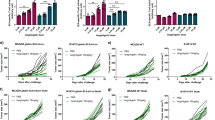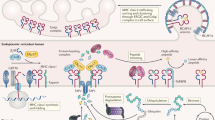Abstract
Cytotoxic T lymphocytes (CTLs) detect and destroy cells displaying class I molecules of the major histocompatibility complex (MHC) that present oligopeptides derived from aberrant self or foreign proteins. Most class I peptide ligands are created from proteins that are degraded by proteasomes and transported, by the transporter associated with antigen processing, from the cytosol into the endoplasmic reticulum, where peptides bind MHC class I molecules and are conveyed to the cell surface1. C2 CTLs, cloned from human CTLs infiltrating a renal cell carcinoma, kill cancer cells overexpressing fibroblast growth factor-5 (FGF-5)2. Here we show that C2 cells recognize human leukocyte antigen-A3 MHC class I molecules presenting a nine-residue FGF-5 peptide generated by protein splicing. This process, previously described strictly in plants3 and unicellular organisms4, entails post-translational excision of a polypeptide segment followed by ligation of the newly liberated carboxy-terminal and amino-terminal residues. The occurrence of protein splicing in vertebrates has important implications for the complexity of the vertebrate proteome and for the immune recognition of self and foreign peptides.
This is a preview of subscription content, access via your institution
Access options
Subscribe to this journal
Receive 51 print issues and online access
$199.00 per year
only $3.90 per issue
Buy this article
- Purchase on Springer Link
- Instant access to full article PDF
Prices may be subject to local taxes which are calculated during checkout






Similar content being viewed by others
References
Yewdell, J. W., Reits, E. & Neefjes, J. Quantitating the MHC class I antigen processing pathway. Nature Rev. Immunol. 3, 952–961 (2003)
Hanada, K., Perry-Lalley, D. M., Ohnmacht, G. A., Bettinotti, M. P. & Yang, J. C. Identification of fibroblast growth factor-5 as an overexpressed antigen in multiple human adenocarcinomas. Cancer Res. 61, 5511–5516 (2001)
Carrington, D. M., Auffret, A. & Hanke, D. E. Polypeptide ligation occurs during post-translational modification of concanavalin A. Nature 313, 64–67 (1985)
Paulus, H. Protein splicing and related forms of protein autoprocessing. Annu. Rev. Biochem. 69, 447–496 (2000)
Rammensee, H., Bachmann, J., Emmerich, N. P., Bachor, O. A. & Stevanovic, S. SYFPEITHI: database for MHC ligands and peptide motifs. Immunogenetics 50, 213–219 (1999)
Huang, W. M. et al. A persistent untranslated sequence within bacteriophage T4 DNA topoisomerase gene 60. Science 239, 1005–1012 (1988)
Burset, M., Seledtsov, I. A. & Solovyev, V. V. Analysis of canonical and non-canonical splice sites in mammalian genomes. Nucleic Acids Res. 28, 4364–4375 (2000)
Steimle, V., Otten, L. A., Zufferey, M. & Mach, B. Complementation cloning of an MHC class II transactivator mutated in hereditary MHC class II deficiency (or bare lymphocyte syndrome). Cell 75, 135–146 (1993)
Evans, T. C. Jr, Benner, J. & Xu, M. Q. The in vitro ligation of bacterially expressed proteins using an intein from Methanobacterium thermoautotrophicum. J. Biol. Chem. 274, 3923–3926 (1999)
Min, W. & Jones, D. H. In vitro splicing of concanavalin A is catalyzed by asparaginyl endopeptidase. Nature Struct. Biol. 1, 502–504 (1994)
McCracken, A. A. & Brodsky, J. L. Evolving questions and paradigm shifts in endoplasmic-reticulum-associated degradation (ERAD). BioEssays 25, 868–877 (2003)
Bacik, I. et al. Introduction of a glycosylation site into a secreted protein provides evidence for an alternative antigen processing pathway: transport of precursors of major histocompatibility complex class I-restricted peptides from the endoplasmic reticulum to the cytosol. J. Exp. Med. 186, 479–487 (1997)
Mosse, C. A. et al. The class I antigen-processing pathway for the membrane protein tyrosinase involves translation in the endoplasmic reticulum and processing in the cytosol. J. Exp. Med. 187, 37–48 (1998)
Acknowledgements
We thank J. R. Bennink and P. F. Robbins for suggestions, comments and encouragement; J. P. Riley and M. R. Parkhurst for the peptide synthesis, and S. A. Rosenberg for continuous support.
Author information
Authors and Affiliations
Corresponding authors
Ethics declarations
Competing interests
The authors declare that they have no competing financial interests.
Rights and permissions
About this article
Cite this article
Hanada, Ki., Yewdell, J. & Yang, J. Immune recognition of a human renal cancer antigen through post-translational protein splicing. Nature 427, 252–256 (2004). https://doi.org/10.1038/nature02240
Received:
Accepted:
Issue Date:
DOI: https://doi.org/10.1038/nature02240
This article is cited by
-
Protein degradation by human 20S proteasomes elucidates the interplay between peptide hydrolysis and splicing
Nature Communications (2024)
-
Non-mutational neoantigens in disease
Nature Immunology (2024)
-
HLA gene variations and mycotoxin toxicity: Four case reports
Mycotoxin Research (2024)
-
Cryptic MHC-E epitope from influenza elicits a potent cytolytic T cell response
Nature Immunology (2023)
-
InvitroSPI and a large database of proteasome-generated spliced and non-spliced peptides
Scientific Data (2023)
Comments
By submitting a comment you agree to abide by our Terms and Community Guidelines. If you find something abusive or that does not comply with our terms or guidelines please flag it as inappropriate.



